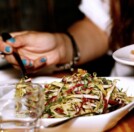4 Carbs To Lose Fat And 4 Carbs To Avoid
Carbohydrates have become a controversial issue in weight loss circles. Some diet gurus advocate diets high in carbohydrates, while others caution dieters to avoid them like the plague.
Weight loss studies have shown that dieters tend to lose weight on both high-carb and low-carb diets. With so much conflicting information, how can you determine what role carbs should play in your personal weight loss plan?
 Fortunately, carbohydrates are not an all or nothing proposition. It’s just a matter of choosing the right ones.
Fortunately, carbohydrates are not an all or nothing proposition. It’s just a matter of choosing the right ones.
Carbs to Eat:
Beans and Nuts
Most Westernized cultures don’t eat enough fiber. The American Dietetic Association recommends 25-35 grams daily, but the American Heart Association estimates that the typical American eats only 15 grams of fiber each day.
This is unfortunate, because fiber has many health benefits. It helps regulate bowel movements, prevents blood sugar spikes and crashes, and keeps your digestive system in good shape.
You can easily increase your fiber intake by adding beans to your diet. Nuts are another good choice. The protein in these foods will help control your hunger, and the fiber will help promote efficient digestion.
Start by eating a half-cup of beans with your meal, and a handful of nuts as a between-meal snack.
Whole Grains
To avoid blood sugar peaks and valleys, switch from refined bread products to whole grains. Your body has to work longer and harder to digest whole grain foods and convert them into energy, thus you avoid the quick peaks and crashes you get from refined carbohydrates.
High-fiber whole grains also tend to satisfy your hunger for longer periods of time, helping you avoid between-meal cravings. Start your day with a cup of whole-grain oatmeal sprinkled with flax seeds for added fiber.
Fruits and Vegetables
Fruits and vegetables are some of the healthiest foods you can consume. Not only are they nutrient-dense, they also contain a significant amount of fiber and water.
In fact, the United States Department of Agriculture recommends 2-4 servings of fruit and 3-5 servings of vegetables each day. The Center for Disease Control also reports that diets rich in fruits and vegetables can help prevent diabetes, cancer, and other diseases.
Try to incorporate a variety of colorful vegetables into your diet. If you’re concerned about eating too much fructose (natural fruit sugar), stick to low-glycemic fruits such as berries, cherries, apricots, grapefruit, and apples.
Dairy Products
Dairy products are a good source of calcium and Vitamin D. Unfortunately, they can also contain a lot of fat and lactose (milk sugar). Control your fat intake by switching to 2% cheese and 1% milk. Low-fat yogurts and string cheese snacks are other tasty dairy choices.
If lactose upsets your stomach, or if you just want to consume less of it, look for lactose-free dairy products instead. They contain all the calcium and vitamins with less of the sugar.
Carbs to Avoid:
Sugar
Ah, the dreaded s-word. What’s so bad about sugar anyway? It contains empty calories, but it’s not so terrible when consumed in moderation.
Sadly, the modern Western diet approaches sugar with anything but moderation. Many processed foods are full of added sugar.
Even foods that don’t taste particularly sweet might contain sugar as a flavor enhancer. Sugar is also used to improve the flavor of many low-fat foods. With so much sugar in our diets, is it any wonder so many dieters suffer from unstable glucose and constant carb cravings?
When it comes to avoiding sugar, do the best you can. Save sweet treats for special occasions, and practice portion control. Don’t rely on artificial sweeteners, as these have been proven to increase sugar cravings in some individuals.
Also, remember to watch out for hidden sugar in your foods. On an ingredient list, sugar can masquerade as high fructose corn syrup, sugar alcohol, sucrose, dextrose, and lactose.
White Flour
Like sugar, simple carbohydrates like white flour are quickly processed by your body, leading to rapid rises and falls in your energy level. Worse, highly refined flour products have very little of the fiber or vitamins your body so desperately needs.
You can add more fiber and nutrition to your diet by trading white bread, rice, and pasta for their whole-grain counterparts.
Also, try eating yams, skins and all, instead of starchy baking potatoes. You will find that these healthier choices leave you more satisfied and less likely to keep eating past the point of satiation.
Fruit Juice
Fruit juices are high in sugar and calories, but low in fiber. It’s much healthier to eat the fruit than to drink only its juice. Plus, many juices are made from “fruit juice concentrate” – another misleading term for added sugar.
After you exercise, try rehydrating with a bottle of water and a piece of fruit. This will give your muscles the quick energy they need to recover, but with the added bonus of fiber.
Alcohol
Unlike food, alcohol is quickly absorbed by the body, passed through the liver, and distributed into the bloodstream. Spikes in blood glucose, and the corresponding crashes, are very common when alcohol is consumed.
Also, alcohol is full of calories that don’t benefit your body. According to the National Institute on Alcohol Abuse and Alcoholism, alcohol can also hinder your body’s ability to absorb nutrients, and can leave you dehydrated.
If you wish to drink alcohol at a special event, forget about sugary mixed drinks and wine coolers. Opt instead for a diet-friendly white wine spritzer, a lite beer, or a shot of rum in a Diet Coke. Be sure not to overindulge; alcohol is notorious for lowering inhibitions, and might make it harder to say no to unhealthy food choices.
You can stop dieting, start eating and start living with The Diet Solution, an all natural diet and nutrition program.




